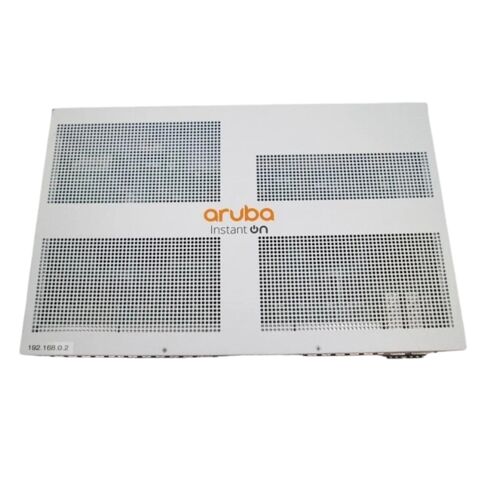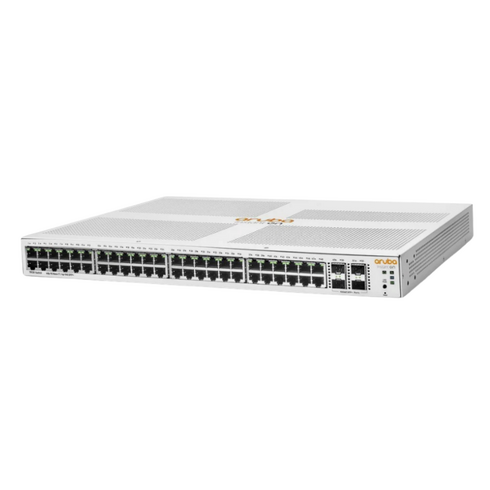JL685-61001 HPE Aruba Instant On 1930 48-Port Managed Network Switches
- — Free Ground Shipping
- — Min. 6-month Replacement Warranty
- — Genuine/Authentic Products
- — Easy Return and Exchange
- — Different Payment Methods
- — Best Price
- — We Guarantee Price Matching
- — Tax-Exempt Facilities
- — 24/7 Live Chat, Phone Support
- — Visa, MasterCard, Discover, and Amex
- — JCB, Diners Club, UnionPay
- — PayPal, ACH/Bank Transfer (11% Off)
- — Apple Pay, Amazon Pay, Google Pay
- — Buy Now, Pay Later - Affirm, Afterpay
- — GOV/EDU/Institutions PO's Accepted
- — Invoices
- — Deliver Anywhere
- — Express Delivery in the USA and Worldwide
- — Ship to -APO -FPO
- — For USA - Free Ground Shipping
- — Worldwide - from $30
Product Specifications of HPE JL685-61001
Device Classification
- Type: Managed Switch
- Port Count: 48 Ports
- Layer: L2+
- Rack Form Factor: 1U
Networking Performance
- Throughput: 130.95 Mpps
- Switching Capacity: 176 Gbps
- Latency:
- 1 Gbps: 2.2 µs
- 10 Gbps: 1.2 µs
Port Specifications
- Standard Ports: 48 x 10/100/1000 Mbpshot
- SFP/SFP+ Ports: 4 x 1G/10G
- Jumbo Frame Size: Up to 9216 Bytes
Routing and Management
Routing Features
- Protocols Supported:
- IGMPv2
- Static IPv4 Routing
- MSTP, RSTP, STP
- Routing Table Capacity: 32 Static Entries
- MAC Address Table: 16,000 Entries
Remote Management Capabilities
- Protocols:
- SNMP (v1, v2c, v3)
- RMON
- HTTP/HTTPS
- TFTP, SCP
- DHCP, IPv4, IPv6
Security and Features
Encryption and Authentication
- Encryption: SSL
- Authentication Method: RADIUS
Additional Features
- Flow Control
- DHCP and ARP Support
- VLAN and Trunking Support
- Auto-Uplink (Auto MDI/MDI-X)
- IGMP Snooping and Port Mirroring
- Quality of Service (QoS)
- IPv4 and IPv6 Support
- Link Aggregation Control Protocol (LACP)
Compliance Standards
- IEEE 802.3
- IEEE 802.3u
- IEEE 802.3ab
- IEEE 802.1Q
- IEEE 802.1x
- IEEE 802.3az
Hardware Specifications
Processor and Memory
- Processor: ARM Cortex-A9, 800 MHz
- RAM: 512 MB
- Flash Storage: 256 MB
Connectivity Options
- RJ-45 Interfaces: 48 x 1000Base-T
- SFP Interfaces: 4 x Gigabit/10G
Power Specifications
Power Supply Details
- Type: Internal Power Supply
- Voltage Requirements: AC 120/230 V (50/60 Hz)
Ports
The HPE Aruba 1930 JL685-61001 Managed Network Switches are equipped with an impressive 48 ports. This feature provides users with a multitude of benefits and plays a crucial role in the overall performance and functionality of the switches.
Increased Connectivity
With 48 ports available, users have the ability to connect a large number of devices to the network switch. This is particularly beneficial for businesses or organizations that have a high demand for network connectivity. The ample number of ports ensures that there is enough capacity to accommodate multiple devices simultaneously, without experiencing any bottlenecks or slowdowns.
Scalability
The abundance of ports also allows for scalability and future growth. As businesses expand and add more devices to their network, having additional ports readily available eliminates the need to invest in additional switches or infrastructure. This not only saves costs but also simplifies network management and reduces complexity.
Flexibility
The 48 ports offer users the flexibility to connect a diverse range of devices, including computers, printers, IP phones, servers, and more. This versatility is especially valuable in environments where multiple types of equipment are utilized. The ability to connect various devices to a single switch streamlines connectivity management and enhances overall network performance.
Furthermore, the HPE Aruba 1930 JL685-61001 Managed Network Switches support different types of ports, including Ethernet and Gigabit Ethernet ports. This enables users to take advantage of high-speed data transfer rates, ensuring efficient and reliable network communication.
Management Interface
The Management Interface of the HPE Aruba 1930 JL685-61001 Managed Network Switches is equipped with both a Web GUI (Graphical User Interface) and CLI (Command-Line Interface). This feature provides users with a user-friendly interface for managing and configuring the switch, contributing to its overall ease of use and convenience.
User-Friendly Web GUI
The Web GUI offers a visual interface that allows users to easily navigate through various settings, configurations, and management options. It presents a graphical representation of the switch's components, making it intuitive for users to understand and operate. The Web GUI typically features a menu-driven structure, enabling users to access different sections and functionalities with just a few clicks. This eliminates the need for complex command inputs, making it accessible to users with varying levels of technical expertise.
Efficient Configuration
The Web GUI also streamlines the configuration process by providing users with an organized and structured environment. It offers wizards or templates that guide users through the setup process, ensuring that all necessary configurations are properly implemented. This reduces the chances of errors or misconfigurations, thereby enhancing network reliability and reducing troubleshooting efforts.
Monitoring and Troubleshooting
The Web GUI provides comprehensive monitoring capabilities, allowing users to keep track of network performance, bandwidth utilization, and device status. Real-time statistics and graphical representations enable users to identify and address potential issues promptly. Additionally, the Web GUI offers troubleshooting tools and diagnostics features that assist in identifying and resolving network problems efficiently.
In addition to the Web GUI, the HPE Aruba 1930 JL685-61001 Managed Network Switches also offer a CLI option. CLI provides advanced users with a command-based interface to interact with the switch. This interface is typically favored by experienced network administrators or technicians who prefer direct control over configurations and commands.
Power Supply
The HPE Aruba 1930 JL685-61001 Managed Network Switches are equipped with an internal power supply. This feature offers several benefits for users, ensuring reliable power delivery to the switch and its connected devices.
Enhanced Reliability
The internal power supply eliminates the need for external power adapters or additional power sources. This reduces the complexity of the setup and minimizes the chances of power failures due to loose connections or faulty adapters. With the power supply integrated into the switch, users can rely on a single, centralized power source, enhancing overall system reliability.
Redundancy and Failover
Internal power supplies often feature redundancy options, allowing for automatic failover in case of a power supply failure. This means that if one power supply unit malfunctions or experiences an outage, another power supply unit takes over seamlessly, ensuring uninterrupted operation. This redundancy feature is particularly important for critical environments where downtime can have severe consequences.
Clean and Organized Setup
With an internal power supply, users can maintain a clean and organized network setup. There are no external power adapters or cables cluttering the environment, reducing cable management complexities and improving aesthetics. This is especially useful in scenarios where space is limited or where a neat and tidy appearance is desired.
PoE Support
The HPE Aruba 1930 JL685-61001 Managed Network Switches offer PoE (Power over Ethernet) support. PoE technology enables the switch to provide both data and power to compatible devices through a single Ethernet cable. This feature brings numerous benefits to users, particularly in scenarios where powering devices separately is impractical or inconvenient.
Simplified Installation
With PoE support, users can conveniently install devices without the need for additional power outlets or wiring. This is especially advantageous in areas where access to electrical outlets may be limited or difficult to reach. Devices such as IP phones, wireless access points, and security cameras can be easily deployed using PoE, reducing installation time and costs.
Flexibility and Mobility
PoE support provides users with the flexibility to position devices in optimal locations without being restricted by power availability. Devices can be placed in areas where power outlets are not easily accessible, allowing for more efficient network design and deployment. PoE also enables greater mobility for devices, as they can be easily moved or relocated without the need for rewiring or additional power considerations.
Centralized Power Management
PoE support allows for centralized power management, providing users with the ability to monitor and control power consumption of individual devices. This helps optimize power usage, identify energy inefficiencies, and reduce overall energy costs. Centralized power management also simplifies maintenance and troubleshooting by providing insights into power-related issues.
Rack Mountable
The HPE Aruba 1930 JL685-61001 Managed Network Switches are designed to be rack mountable, offering users the convenience of easily integrating them into existing rack infrastructure.
Space Efficiency
Rack mounting allows for space-efficient deployment of the switches, ensuring optimal utilization of rack space. This is particularly important in data centers or server rooms where space is limited and every inch counts. By placing the switches neatly in a rack, users can maximize their available space and maintain an organized network environment.
Improved Cable Management
Rack mounting facilitates proper cable management practices by providing dedicated cable management features. These features include cable trays, routing options, and tie-down points that help organize and secure cables, reducing clutter and improving airflow within the rack. Proper cable management not only enhances the reliability and performance of the network but also simplifies future maintenance and troubleshooting tasks.
Scalability and Expandability
Rack mountable switches allow for easy scalability and expandability. Users can easily add additional switches to the rack as their network requirements grow, without the need for complex rearrangements or reconfigurations. This scalability ensures that the network infrastructure can adapt to evolving needs, making it a cost-effective and future-proof solution.













